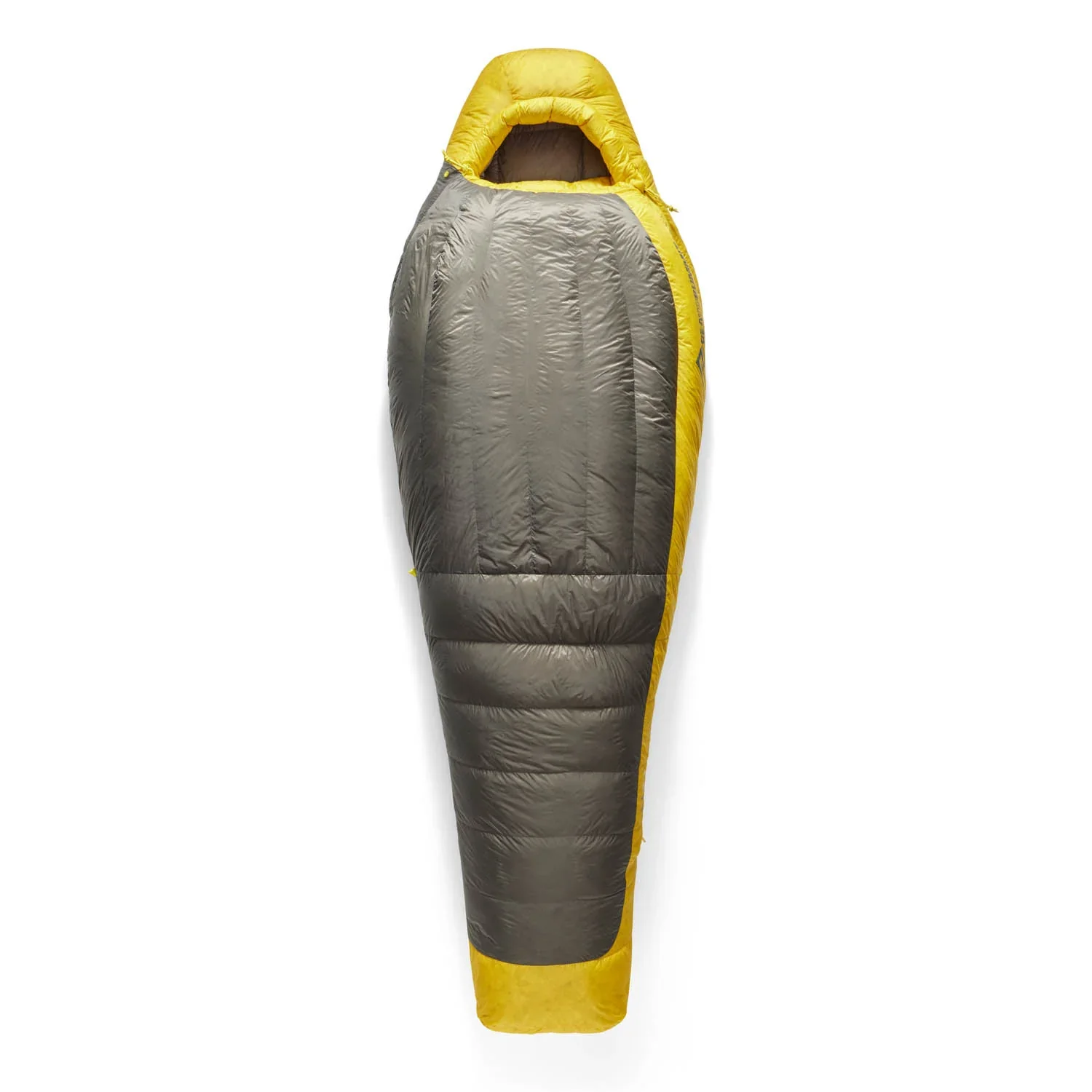Sea to Summit Spark 30 Sleeping Bag Review
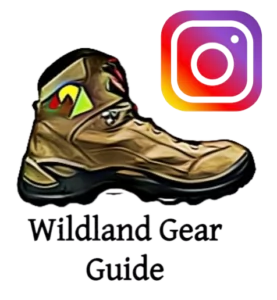 Don't forget to follow us on Instagram for the latest gear news!
Don't forget to follow us on Instagram for the latest gear news!
Hello hikers! I’m Samantha Cooke, a full-time hiking guide with Wildland Trekking. One of the most crucial pieces of gear for any backpacker is the sleeping bag. It’s your refuge after a long day on the trail, your cozy nook to unwind in the backcountry, and your warm bed on chilly nights. From cold mountain nights on our Rocky Mountain National Park hiking tours to forest excursions while trekking Olympic National Park, a good sleeping bag is pivotal to success. But sleeping bags come in all shapes and sizes, and finding the perfect one can be a painstaking process – a process that I’ve personally been working on for years.
Therefore, I was delighted to accept the opportunity to try out Sea to Summit’s Spark 30 Sleeping Bag this summer while leading trips in Zion and Rocky Mountain National Parks. With a strong track record of high-quality, lightweight sleeping bags behind them, I was extremely hopeful that the Spark might finally be the answer to my years-long search for the perfect sleeping bag. So let’s see how it did!
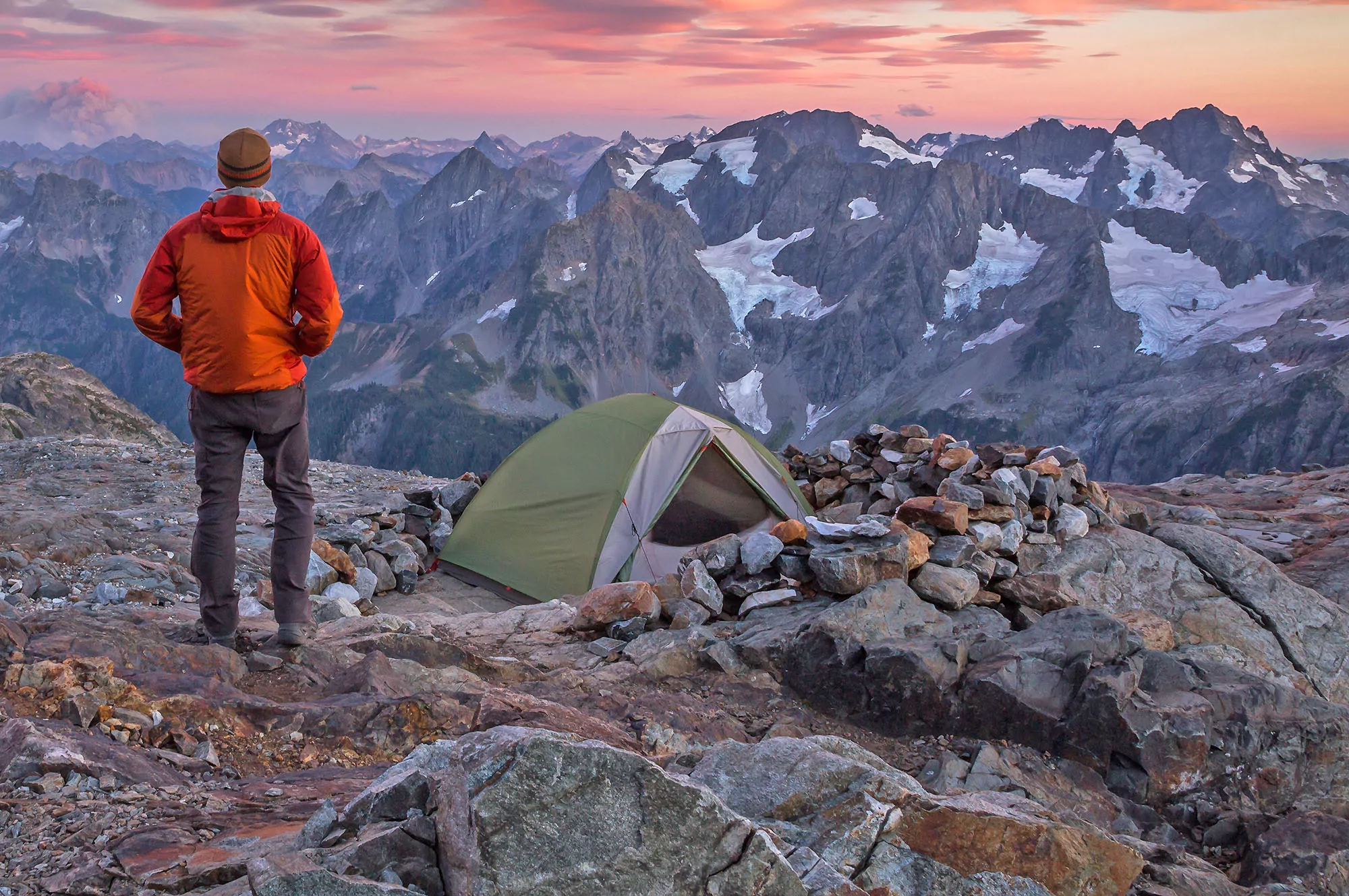
Sea to Summit Spark 30 Quick Look
Let’s start by taking a look at the basic specifications of the Spark 30 to set the framework for this review.
- MSRP: $429.00
- Weight: 1lbs 1.4 oz
- Compressed Volume: 4.5 Liters
- Fill: RDS certified, 850+ non-PFAS Ultra-Dry Down
- Shell Material: 10D Nylon
Intended Use
The “Spark” line of sleeping bags from Sea to Summit is designed for backpacking, mountaineering, and any other adventure where your pack weight is critical. With 850+ fill power down, this sleeping bag delivers exceptional insulation without weighing you down. The lightweight shell materials continue this low-weight trend, making these sleeping bags a good choice for hikers who want to invest in a premium-level sleeping bag in order to reap the benefits of the good weight-to-performance ratio.
Spark 30 Notable Features
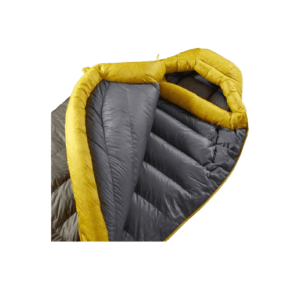
The Spark 30 Sleeping Bag has several important features worth discussing before we get too deep into this review. Let’s take a look at them below:
- 850+ Goose Down Fill – is exceptionally high quality, providing some of the best warmth-to-weight ratios on the market (more on this towards the end of the review).
- Down-Filled Draft Collar – follows the entire zipper and effectively locks in warmth. My testing also found that the zipper rarely snagged on this collar.
- Durable Water Repellent (DWR) Treatment – keeps the hood and footbox (two high-moisture areas) highly resistant to water and condensation.
Sea to Summit Background
Roland Tyson first started the Sea to Summit Brand in Perth, Australia in the 1990s. Very appropriately named, Sea to Summit provides gear to conquer any adventure from on the sea all the way to the tippy top of the highest summits. Even more impressively, Sea to Summit has carved out a hard-won reputation for quality and performance while fielding this vast array of products across many different adventures. In addition to their push for high quality and performance, Sea to Summit also offers a solid warranty to back up their products along with placing a strong emphasis on sustainability within their organization for recycling, climate activism, and responsible product design.
THE TEST – QUICK OVERVIEW
For the desert portion of my gear testing in Utah, I experienced mostly warm to hot temperatures. During the spring, the temperature was between 40-55 degrees at night. During the summer months the evening temperatures got even warmer topping out between 65 - 80 degrees.
As the summer temperatures ran me out of the desert and to the mountains for relief, I experienced much more cooler temperatures in the Grand Tetons, the Wind River Range and Colorado. I would say it was a consistent 35-40 degrees in the morning in the mountains. The only precipitation I encountered was waking up to the condensation on the inside of the tent. Apart from that condensation, it was a very dry desert and mountain season.
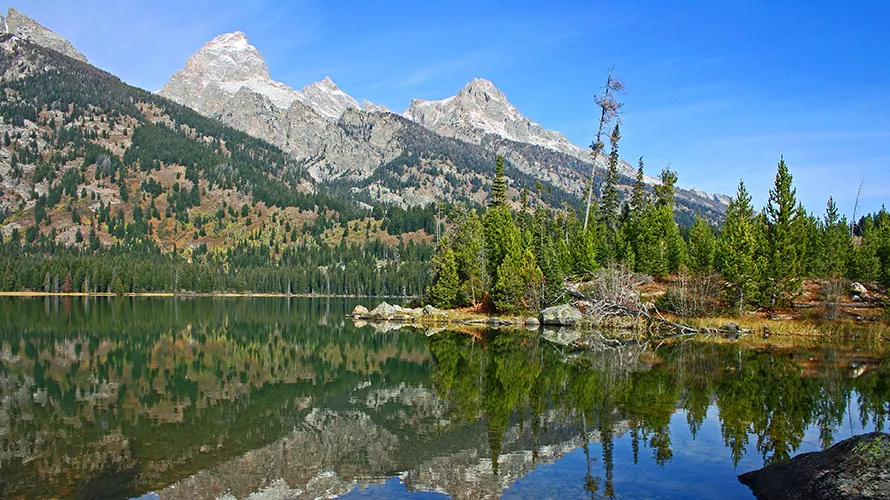
The Review
Now that we’ve established the basic specifications for the Spark 30 sleeping bag and some background information about the Sea to Summit brand, it’s time to dive into the complete review. Below, I’ll cover the main performance criteria for sleeping bags and give the Spark 30 a score from 1 to 5, where 5/5 is the best possible score. The key to these score meanings is below, and in addition to the score, I’ll go into detail about the testing experience that led me to assign that particular score. So, let’s see how this sleeping bag did!
Scoring Key
1/5: Poor
2/5: Tolerable
3/5: Fair
4/5: Good
5/5: Excellent
Comfort – 4/5
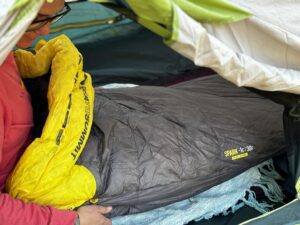
The overall comfort of this sleeping bag is very good.
First off, the shoulder width is wide enough for a person like myself who has a wingspan like that of an outstretched California Condor. Additionally, the hip and toe box were spacious enough for an unrestricted yet comfortable feel. I was able to sleep on my side during testing and still felt like there was room in the bag to move around. This last point is a massive positive since feeling overly constrained is hugely uncomfortable for me.
The high-quality down loft of the sleeping bag also aids in overall comfort. It is light and airy, making it easy to forget that I’m in a sleeping bag.
I am a tall lady and have curves, which can make sleeping bag shopping somewhat challenging. I am right at the maximum height for this long-length sleeping bag. Even though I was right at the maximum length for this bag, I still found it to be spacious, roomy, and not restrictive. I like a snug but loose-fitting mummy-style bag, which this provided.
Weight and Packability – 5/5
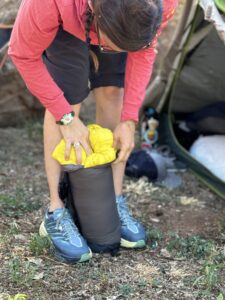
This sleeping bag is amazingly light. At just 1 Lb. 6.5oz. it feels like nothing when loaded into my backpack. It comes with an 8L compression sack. When synched down, it is comparable to the height of a 1L Nalgene water bottle with about a 7” circumference, leaving a lot of space in my backpack.
The other impressive quality of this sleeping bag is that it is equipped with 850+ ultra-dry down fill. My mind is blown at how small this sleeping bag can compress down with such a high fill rating while still providing great comfort and warmth retention.
So, this sleeping bag gets full marks for weight and packability! Sea to Summit seems to have hit the bullseye by keeping this item super backpacker-friendly with a lightweight and exceptionally compressible design.
Durability – 4/5
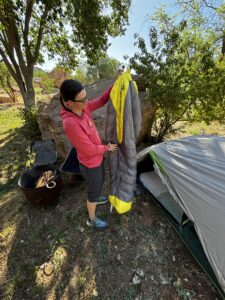
So far, this bag has survived my durability testing in the rugged desert and mountains.
First, let’s talk zippers. The zipper design on the Spark sleeping bag is quite clever; It doesn’t get caught on the bevels when zipping or unzipping and doesn’t snag on the draft collar that follows its path. On top of gliding well, this zipper is just plain bomber! I don’t think it will ever come off the slide.
Moving on to the shell, the fabric used to construct this sleeping bag is 10-Denier nylon. It feels soft and delicate to the touch. Normally, I’d be concerned about such thin material, but in this case, it’s definitely exceeding my expectations. I’ve been really hard on this sleeping bag during my testing and guiding season and haven’t yet managed to put a hole in it.
However, the included compression sack is not fairing so well. One of the straps is starting to come away from the seam. I must have synched it down a little too much. But still, I would hope that the seams on a compression sack would handle the pressure of cinching down a sleeping bag. Therefore, I deducted one point from the durability score to reflect this issue.
Warmth – 4/5
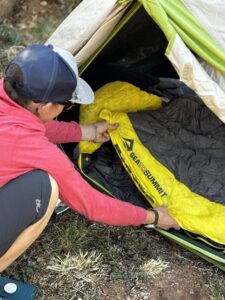
I am seriously considering utilizing this sleeping bag as my year round sleeping bag.
It is rated as a 30-degree bag, but its heat retention is unbeatable. On cold nights in the Tetons, I shoved a few extra layers into the bag, and it was way too hot. This was doubly surprising since I am typically a cold sleeper. This sleeping bag’s packability-to-warmth ratio is simply unmatched, in my opinion.
The only piece of criticism I can find about this bag is that the zipper does not go down the entire length of the bag. Sea to Summit refers to this technical feature as a “minimalist half-length” zipper (likely saving some weight and improving packability). But I call it a slight inconvenience on those hot summer nights when it’s way too hot to sleep inside a sleeping bag, and all I want to do is open it up and throw a leg out. Over the course of my field testing, I would often catch myself thinking, “I wish this had a full-length zipper.” That is the missing link to this well-constructed and thought-out sleeping bag.
My last observation is that this is my third sleeping bag with vertical bevels on the upper half. I do think having the down within a vertical bevel envelope instead of a horizontal bevel helps keep the down insulation in place instead of clumping over time, so that’s another effective and well-thought-out design point.
Overall Quality – 4/5
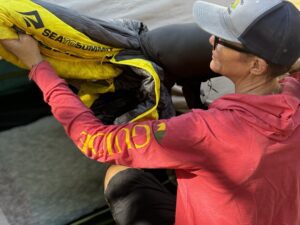
It’s often tricky to predict if a particular product will last for years and years after just a few months of testing. But in this case, the Spark 30 is my second Sea to Summit sleeping bag, and my first is still in heavy rotation – which speaks volumes for Sea to Summit’s overall quality and durability. What’s more, the Spark 30 fully appears to carry on this overall quality to be an exceptional sleeping bag.
Specifically, I think this sleeping bag is true to how it is marketed. It has an outstanding balance of warmth to weight, with a little extra space in the toe box and shoulders combined with excellent thermal efficiency for a great night’s sleep.
While testing this sleeping bag in Grand Teton National Park, I noticed significant condensation build-up on the exterior of my sleeping bag in the morning. To my surprise, the sleeping bag dried extremely fast, and the integrity of the loft didn’t seem compromised at all (since down loses its insulative capability when wet). That is a major positive for this bag. A down bag that can get wet, dry fast, and maintain its thermal regulation in the mountains is a winner in my book. This observation really lends itself to the technology used in the construction of this bag. The Ultra-Dry Down water-repellent treatment used to protect the down from external moisture is second to none. However, I am curious how long the repellent treatment will last in the future.
The other feature that lends to the overall quality of this sleeping bag is the draft tube that runs along the side of the zipper. I was shocked that the zipper did not get snagged here very often. I was also thrilled at how much of a difference that little feature can make at keeping the maximum amount of heat inside the bag. It was truly amazing.
Price – 3/5 (Fair)
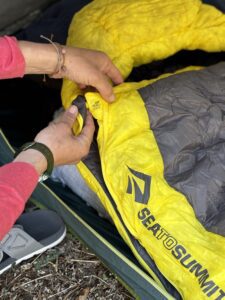
Let’s face it: quality down sleeping bags are expensive. It’s a painful reality, but the Spark 30 is no different. I think it is right at the top of what I would be willing to pay for a sleeping bag, considering all of the wonderful features mentioned earlier. Therefore, I believe the price to be fair for what you receive. It’s not a steal by any stretch of the imagination, but for the significant financial investment in this sleeping bag, you’re receiving equally significant quality and performance that makes the investment worth it.
The one major drawback – for me – is not having a full-length zipper. This is such a nice feature to have on those hot nights where you just want to kick a leg out to cool off. Therefore, it’s very hard for me to justify paying close to $500.00 for a sleeping bag that doesn’t have a full-length zipper. But if this isn’t a dealbreaker for you, then I stand by my earlier verdict that this bag is fairly priced.
Bringing It Together
There’s certainly a lot to unpack with the Sea to Summit Spark 30. Therefore, let’s bring all the pros and cons together below and take a comprehensive look at what this sleeping bag brings to your adventures.
Pros:
- Extremely lightweight and compressible
- Superior warmth retention
- Proven water resistance
- Reliable zipper design
- Effective draft collar
- Durable shell material
- High quality down insulation
Cons:
- Very Expensive
- No full-length zipper
- Included compression sack is a little flimsy
How good is 850+ Fill Goose Down?
All down sleeping bags come with an abstract fill number. 600, 700, or in the case of the Spark, 850. But what does that number even mean?
The down fill power number directly refers to the down’s loft – or puffiness – factor. The higher the fill power, the better the loft.
To put some specific numbers into this story, the fill power refers to how many cubic inches a single ounce of down occupies. Therefore, 1 ounce of 600-fill down takes up 600 cubic inches when uncompressed. Similarly, 1 ounce of 850-fill down (like what we have with the Spark sleeping bag) takes up 850 cubic inches.
So the higher the fill power (the more loft you get per ounce), the better the down quality. This scale typically ranges from 500 to 900 fill power. Therefore, at 850+ fill power, we can safely say that the Sea to Summit Spark is packing some excellent quality down.
Final Thoughts
Overall, I was extremely impressed by the Sea to Summit Spark 30.
First, the items I liked. The down loft and accompanying moisture-resistant treatment are absolutely outstanding. This goose down’s ability to pack down super small for transport yet still have enough oomph when deployed to retain a crazy amount of heat is remarkable. The draft collar, excellent down insulation, and perfectly sized interior all work together to make this a super cozy cocoon that’s not too tight nor too loose (and I’m a side sleeper, which makes the perfect sizing all the more impressive). I encountered significant condensation on several mornings, significantly wetting the sleeping bag. Still, the moisture-resistant down treatment worked its magic, and the down insulation didn’t clump up at all and dried exceptionally fast. Add a durable shell material and reliable zipper that rarely snags, and this is one solid sleeping bag.
My drawbacks mostly center on aesthetics since not a single feature or component failed on the sleeping bag during my testing. First off, I do prefer a full-length zipper over the half-zipper provided with the Spark. This provides some extra temperature control, especially if you get too hot. Therefore, I found the Spark a little limiting with the half zipper. Additionally, the included compression sack proved to be a little flimsy, and I’d prefer Sea to Summit up their game in this department since a premium product also deserves premium accessories.
Despite those drawbacks, the Spark 30 is truly an outstanding sleeping bag for folks willing to make a significant investment in their backcountry comfort. If you’re ready for a premium-level sleeping bag, the Spark 30 won’t disappoint. Its fantastic warmth-to-weight ratio, excellent materials, and cozy design should support your adventures year after year.





